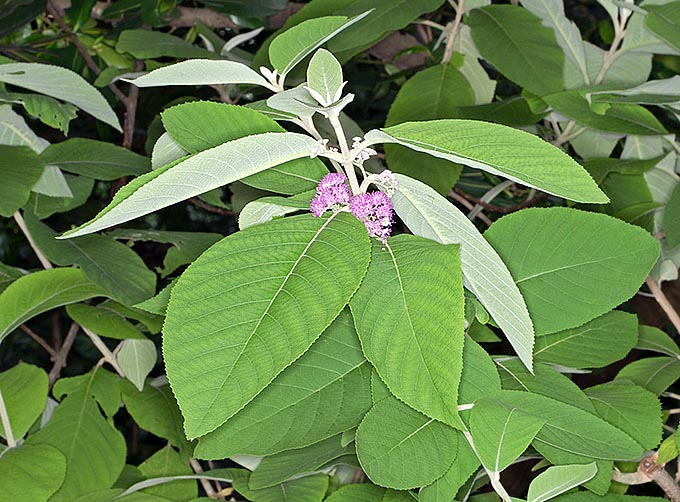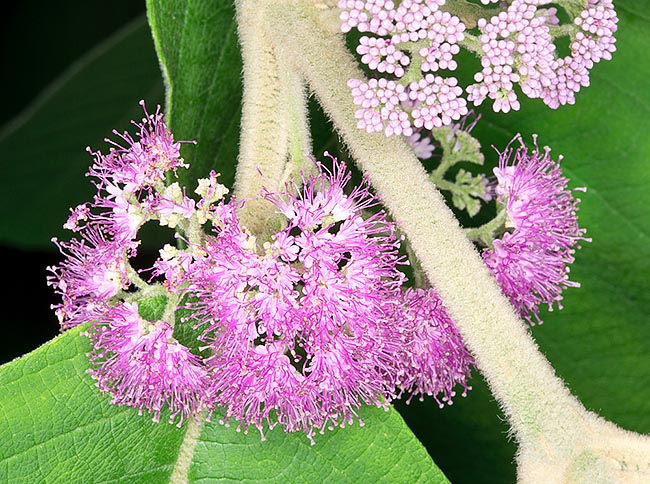Family : Lamiaceae

Text © Pietro Puccio

English translation by Mario Beltramini

The Callicarpa formosana is a 1-3 m shrub present in Formosa (Taiwan), as the name suggest, but also in China, Japan and Philippines in the subtropical forests and mountain thickets up to about 1600 m of altitude © Giuseppe Mazza
The generic name is the combination of the Greek substantives “κάλλος” (kallos) = beauty and “καρπός” (karpos) = fruit, with obvious reference; the specific name is the Latin adjective “formosanus, a, um” = of Formosa (Taiwan), with reference to pone of its origin sites.
Common names: Formosan beauty berry, Formosan beautybush, Taiwan blue berry, Taiwan purple pearls, (English); du hong hua, tsu kang tzai (Chinese); palis, papalsis, tambalasi, tigau-na-itim, tigaw, tubang-dalag (Tagalog); houraimu- rasaki (Japanese); nàng nàng đài loan, tử châu đài loan (Vietnamese).
The Callicarpa formosana Rolfe (1882) is an evergreen shrub, 1-3 m tall, with tendentially drooping branches and leaves, on a 1,5-2,5 cm long petiole, opposite, simple, elliptic to oblong-lanceolate, 6-15 cm long and 2-8 cm broad, with long pointed apex and minutely serrate margins, slightly shaggy and rough above, covered below by greyish tomentum; the young branches, petioles and peduncles are densely covered by greyish stellate hairs.
The inflorescences, on a 0,5-2 cm long peduncle, are axillary cymes of 3-4 cm of diameter carrying numerous bisexual flowers with campanulate calyx, 1-1,5 mm long, with 4 triangular lobes, glabrous imbutiform corolla, about 2,5 mm long, with 4 oblong lobes, about 1-1,3 mm long and 1 mm broad, of purple pink colour, and 4 stamina, 4-6 mm long.
The fruits are globous drupes of lavender colour, of about 2-3 mm of diameter, long-lasting on the plant, containing 4 woody pyrenae (nutlets), each one containing only one ellipsoid seed, 1,2 mm long.

Ornamental plant, due to the showy axillar inflorescences, but also medicinal for various pathologies. The leaves contain and insecticidal substance and are locally used for stunning and catching the fishes © Giuseppe Mazza
Species adaptable to various conditions of cultivation and climates, from the tropical to the temperate one, and even if preferring high temperatures during the growth period, 20-30 °C, it can bear lowest values of temperature up to about -8 °C. Requires full sun or at the most slight shade and soils from slightly acidic to neutral maintained constantly humid, when adult can resist short periods of drought.
It is cultivated for ornamental purposes for mixed edges and in gardens for butterflies, it also adapts to the cultivation in pot, utilizing a loam rich of humus with addition of siliceous sand or perlite per a 30%, with regular waterings, but without stagnations, and fertilizations in spring summer preferably with products rich of phosphorus and potassium in order to stimulate the blooming and the fructification.
All parts of the plant are utilized in the traditional Chinese medicine for various pathologies, mainly rheumatisms, mouth infections and gastrointestinal disorders; the leaves, due to the presence of toxic compounds, are locally utilized for stunning the fishes and for easily catching them, moreover, they contain a substance having insecticidal properties.
Currently (2014), the species is not accepted by the whole scientific community, a part considers it a synonym of Callicarpa pedunculata R.Br. (1810); the most evident difference concerns the peduncle of the inflorescence, shorter than the petiole in the Callicarpa formosana, longer in the Callicarpa pedunculata.
Synonyms: Callicarpa bicolor Fern.-Vill. (1880); Callicarpa blancoi Rolfe (1884); Callicarpa ovata C.B.Rob. (1908); Callicarpa ningpoensis Matsuda (1913); Callicarpa aspera Hand.-Mazz. (1922); Callicarpa rubella f. robusta C.Pei (1932); Callicarpa integerrima var. serrulata H.L.Li (1944); Callicarpa brevipes var. glabrescens Moldenke (1952).
→ To appreciate the biodiversity within the family LAMIACEAE please click here.
